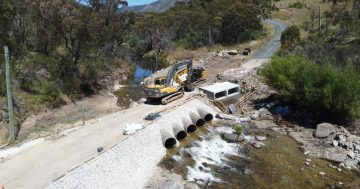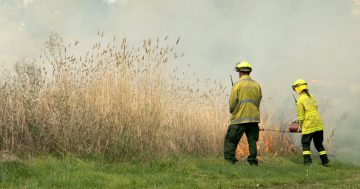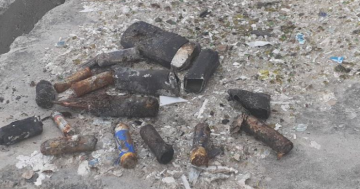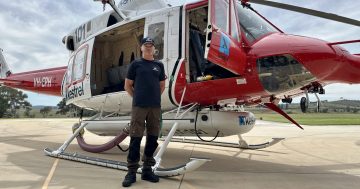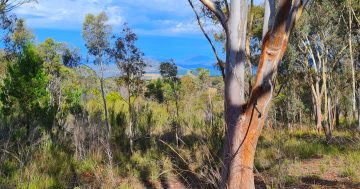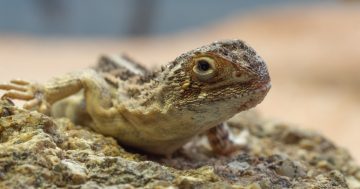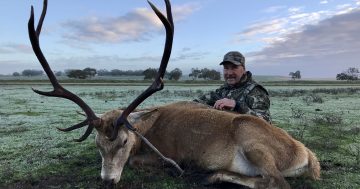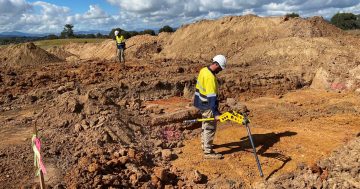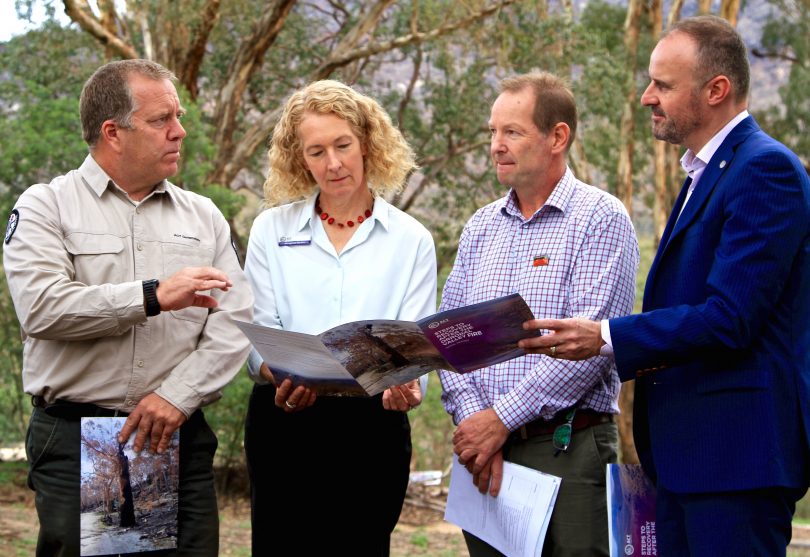
ACT Chief Minister Andrew Barr (right) discusses the initial report on recovery after the Orroral Valley fire with ACT Parks and Conservation manager Justin Foley, report team leader Dr Margaret Kitchin and ACT conservator of flora and fauna Ian Walker. Photo: Michael Weaver, Region Media.
The Orroral Valley bushfire may have been declared ‘out’ earlier this week, but it will continue to burn a hole in the ACT Budget according to the Chief Minister and Treasurer Andrew Barr.
Mr Barr didn’t rule out the possibility of Canberrans paying higher taxes to help balance what is a clear need for the government to invest in greater capabilities for the ACT’s emergency services, as well as the Territory’s response to coronavirus.
“The budget will be dramatically impacted by the summer’s events,” Mr Barr said while unveiling the findings of the initial report into the Orroral Valley fire.
“There will be a need for some significant investment in the millions of dollars. Our resources are not going to be as plentiful as would have been the case before all of these economic shocks, but it’s clear that the need for government to invest in the short, medium and long-term is absolutely essential.
“There is the need to invest in a greater capability for the fire and emergency services, the Rural Fire Service, and Parks and Conservation in terms of how we would respond to future fire threats.”
Mr Barr said there is also a question as to what is and isn’t covered by insurance, which is further balanced by reduced income from the goods and services tax.
“This forthcoming Territory budget will be the most difficult one that we have had to frame. We will be needing to spend and we’ll need to coordinate that spending across different levels of government. That will be part of the COAG [Council of Australian Governments] discussions that treasurers will have in Perth at the end of this month,” the Chief Minister said.
“I’m confident that the community understands the importance of the investments that will need to be made. I am less confident of their willingness to pay considerably more in taxation, and that’s certainly a factor that does weigh on my mind at this time.”
While there are funds available from the Commonwealth, Mr Barr said it had been frustrating that the pool of money available to States and Territories had not been flowing more quickly.
The Chief Minister was also critical of the late arrival and working order of aerial assets that eventually saved so much of the ACT’s natural environment during the height of the Orroral Valley fire. He said investment in a pool of aerial firefighting appliances was an absolute must, as was funding for the protection of wildlife.
“The aerial appliances that saved a lot of the park and a lot of property arrived a bit late and weren’t always in great working order initially – that’s why some of the DC10s took a while to get here because they weren’t ready and they were flown in at the last minute.
“We can’t have another bushfire season like this one, so I think that message has gotten through loud and clear,” Mr Barr said as the ACT Government puts its wishlist together for the next round of COAG discussions, as well as the focus of the forthcoming bushfire royal commission.
“I will be ensuring that issues pertaining to hazard reduction burns, land management and clearing will have an airing at a national level and that our local circumstances are acknowledged and respected as we move forward in the response to this last summer, but also in preparation for summers ahead.”

The Glendale Depot was one area of the Namadgi National Park to escape the Orroral Valley fire. Photo: Michael Weaver, Region Media
In releasing the initial report into the steps to recovery after the Orroral Valley fire, the government has been formally presented with 27 identified risks.
They include:
- impacts on cultural heritage such as rock art, archaeological sites, stone arrangements, heritage trees and huts
- risks to public safety from damage to roads, walking tracks and dangerous trees
- impacts on threatened ecological communities including our alpine bogs
- threats to biodiversity from feral animals and invasive species
- risks to biodiversity including aquatic species, large gliders, threatened flora and fauna, fire-sensitive communities and hollow-bearing trees
- impacts on water quality from sediments and nutrients in water catchments
- hillslope erosion, and
- damage to park and rural landholder assets such as fencing and visitor infrastructure.
Dr Margaret Kitchin has led the Rapid Risk Assessment Team of 13 people that include flora, fauna and fire ecologists, hydrologists, archaeologists and infrastructure experts. A second stage will address recovery planning and delivery that will consider issues such as climate change and adaptation, continual dry conditions and safeguarding Canberra’s water supply.
The ACT Government has also worked closely with Ngunnawal people and Representative Aboriginal Organisations to support them in the healing of Country and the conservation of cultural sites.
“Some of these areas were burnt in 2003, they did recover and they will recover again. It is a changing climate, and where we can, we will build resilience into our assets, maybe designing them differently, but also letting nature take its course,” Dr Kitchin said.
The full Rapid Risk Assessment Team report is available on the ACT Government website.
